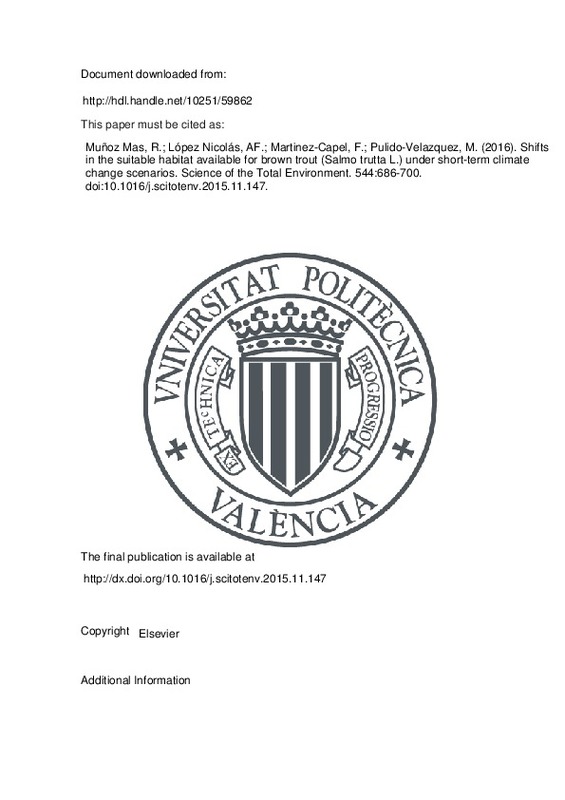JavaScript is disabled for your browser. Some features of this site may not work without it.
Buscar en RiuNet
Listar
Mi cuenta
Estadísticas
Ayuda RiuNet
Admin. UPV
Shifts in the suitable habitat available for brown trout (Salmo trutta L.) under short-term climate change scenarios
Mostrar el registro sencillo del ítem
Ficheros en el ítem
| dc.contributor.author | Muñoz Mas, Rafael
|
es_ES |
| dc.contributor.author | López Nicolás, Antonio Francisco
|
es_ES |
| dc.contributor.author | Martinez-Capel, Francisco
|
es_ES |
| dc.contributor.author | Pulido-Velazquez, M.
|
es_ES |
| dc.date.accessioned | 2016-01-13T16:51:06Z | |
| dc.date.available | 2016-01-13T16:51:06Z | |
| dc.date.issued | 2016-01 | |
| dc.identifier.issn | 0048-9697 | |
| dc.identifier.uri | http://hdl.handle.net/10251/59862 | |
| dc.description.abstract | The impact of climate change on the habitat suitability for large brown trout (Salmo trutta L.) was studied in a segment of the Cabriel River (Iberian Peninsula). The future flow and water temperature patterns were simulated at a daily time step with M5 models' trees (NSE of 0.78 and 0.97 respectively) for two short-term scenarios (2011 2040) under the representative concentration pathways (RCP 4.5 and 8.5). An ensemble of five strongly regularized machine learning techniques (generalized additive models, multilayer perceptron ensembles, random forests, support vector machines and fuzzy rule base systems) was used to model the microhabitat suitability (depth, velocity and substrate) during summertime and to evaluate several flows simulated with River2D©. The simulated flow rate and water temperature were combined with the microhabitat assessment to infer bivariate habitat duration curves (BHDCs) under historical conditions and climate change scenarios using either the weighted usable area (WUA) or the Boolean-based suitable area (SA). The forecasts for both scenarios jointly predicted a significant reduction in the flow rate and an increase in water temperature (mean rate of change of ca. −25% and +4% respectively). The five techniques converged on the modelled suitability and habitat preferences; large brown trout selected relatively high flow velocity, large depth and coarse substrate. However, the model developed with support vector machines presented a significantly trimmed output range (max.: 0.38), and thus its predictions were banned from the WUA-based analyses. The BHDCs based on the WUA and the SA broadly matched, indicating an increase in the number of days with less suitable habitat available (WUA and SA) and/or with higher water temperature (trout will endure impoverished environmental conditions ca. 82% of the days). Finally, our results suggested the potential extirpation of the species from the study site during short time spans. | es_ES |
| dc.description.sponsorship | The study has been partially funded by the IMPADAPT project (CGL2013-48424-C2-1-R) - Spanish MINECO (Ministerio de Economia y Competitividad) - and FEDER funds and by the Confederacion Hidrografica del Jucar (Spanish Ministry of Agriculture, Food and Environment). We are grateful to the colleagues who worked in the field and in the preliminary data analyses, especially Juan Diego Alcaraz-Henandez, David Argibay, Aina Hernandez and Marta Bargay. Thanks to Matthew J. Cashman for the academic review of English. Finally, the authors would also to thank the Direccion General del Agua and INFRAECO for the cession of the trout data. The authors thank AEMET and UC by the data provided for this work (dataset Spain02). | en_EN |
| dc.language | Inglés | es_ES |
| dc.publisher | Elsevier | es_ES |
| dc.relation.ispartof | Science of the Total Environment | es_ES |
| dc.rights | Reserva de todos los derechos | es_ES |
| dc.subject | Bivariate habitat duration curves | es_ES |
| dc.subject | Machine learning | es_ES |
| dc.subject | Mediterranean river | es_ES |
| dc.subject | Models' ensemble | es_ES |
| dc.subject | Salmo trutta | es_ES |
| dc.subject | Water temperature | es_ES |
| dc.subject.classification | INGENIERIA HIDRAULICA | es_ES |
| dc.subject.classification | TECNOLOGIA DEL MEDIO AMBIENTE | es_ES |
| dc.title | Shifts in the suitable habitat available for brown trout (Salmo trutta L.) under short-term climate change scenarios | es_ES |
| dc.type | Artículo | es_ES |
| dc.identifier.doi | 10.1016/j.scitotenv.2015.11.147 | |
| dc.relation.projectID | info:eu-repo/grantAgreement/MINECO//CGL2013-48424-C2-1-R/ES/ADAPTACION AL CAMBIO GLOBAL EN SISTEMAS DE RECURSOS HIDRICOS/ | es_ES |
| dc.rights.accessRights | Abierto | es_ES |
| dc.contributor.affiliation | Universitat Politècnica de València. Instituto de Investigación para la Gestión Integral de Zonas Costeras - Institut d'Investigació per a la Gestió Integral de Zones Costaneres | es_ES |
| dc.contributor.affiliation | Universitat Politècnica de València. Instituto Universitario de Ingeniería del Agua y del Medio Ambiente - Institut Universitari d'Enginyeria de l'Aigua i Medi Ambient | es_ES |
| dc.contributor.affiliation | Universitat Politècnica de València. Departamento de Ingeniería Hidráulica y Medio Ambiente - Departament d'Enginyeria Hidràulica i Medi Ambient | es_ES |
| dc.description.bibliographicCitation | Muñoz Mas, R.; López Nicolás, AF.; Martinez-Capel, F.; Pulido-Velazquez, M. (2016). Shifts in the suitable habitat available for brown trout (Salmo trutta L.) under short-term climate change scenarios. Science of the Total Environment. 544:686-700. https://doi.org/10.1016/j.scitotenv.2015.11.147 | es_ES |
| dc.description.accrualMethod | S | es_ES |
| dc.relation.publisherversion | http://dx.doi.org/10.1016/j.scitotenv.2015.11.147 | es_ES |
| dc.description.upvformatpinicio | 686 | es_ES |
| dc.description.upvformatpfin | 700 | es_ES |
| dc.type.version | info:eu-repo/semantics/publishedVersion | es_ES |
| dc.description.volume | 544 | es_ES |
| dc.relation.senia | 298490 | es_ES |
| dc.contributor.funder | Ministerio de Economía y Competitividad | es_ES |
| dc.contributor.funder | European Regional Development Fund | es_ES |
| dc.contributor.funder | Confederación Hidrográfica del Júcar | es_ES |







![[Cerrado]](/themes/UPV/images/candado.png)

